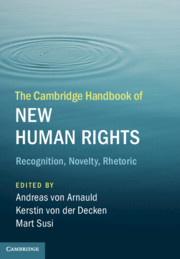Book contents
- The Cambridge Handbook of New Human Rights
- The Cambridge Handbook of New Human Rights
- Copyright page
- Contents
- Figures
- Contributors
- Acknowledgements
- Introduction
- Part I Cross-Cutting Observations
- Part II Public Good Rights
- Part III Status Rights
- Rights of Older Persons
- Rights to Gender Identity
- 14 Gender Recognition as a Human Right
- 15 Pre-existing Rights and Future Articulations
- Rights of Indigenous Peoples
- Animal Rights
- Part IV New Technology Rights
- Part V Autonomy and Integrity Rights
- Part VI Governance Rights
- Index
14 - Gender Recognition as a Human Right
from Rights to Gender Identity
Published online by Cambridge University Press: 04 January 2020
- The Cambridge Handbook of New Human Rights
- The Cambridge Handbook of New Human Rights
- Copyright page
- Contents
- Figures
- Contributors
- Acknowledgements
- Introduction
- Part I Cross-Cutting Observations
- Part II Public Good Rights
- Part III Status Rights
- Rights of Older Persons
- Rights to Gender Identity
- 14 Gender Recognition as a Human Right
- 15 Pre-existing Rights and Future Articulations
- Rights of Indigenous Peoples
- Animal Rights
- Part IV New Technology Rights
- Part V Autonomy and Integrity Rights
- Part VI Governance Rights
- Index
Summary
Protecting LGBT people from violence and discrimination does not require the creation of a new set of LGBT-specific rights, nor does it require the establishment of new international human rights standards. The legal obligations of States to safeguard the human rights of LGBT people are well established in international human rights law on the basis of the Universal Declaration of Human Rights and subsequently agreed international human rights treaties.
- Type
- Chapter
- Information
- The Cambridge Handbook of New Human RightsRecognition, Novelty, Rhetoric, pp. 193 - 206Publisher: Cambridge University PressPrint publication year: 2020
- 4
- Cited by

